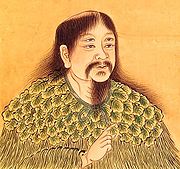Cangjie
| Cangjie | |||||||||||||||||||||

Portrait of Cang Jie showing his four eyes and four pupils
|
|||||||||||||||||||||
| Traditional Chinese | 倉頡 | ||||||||||||||||||||
|---|---|---|---|---|---|---|---|---|---|---|---|---|---|---|---|---|---|---|---|---|---|
| Simplified Chinese | 仓颉 | ||||||||||||||||||||
|
|||||||||||||||||||||
| Transcriptions | |
|---|---|
| Standard Mandarin | |
| Hanyu Pinyin | Cāngjié |
| Wade–Giles | Ts'ang1-chieh2 |
| IPA | [tsʰáŋtɕjě] |
| Yue: Cantonese | |
| Yale Romanization | Chōng-kit |
| Jyutping | Cong1-kit3 |
| Southern Min | |
| Tâi-lô | Tshong-khiat (lit.) Tshng-khiat (col.) |
Cang Jie (Chinese: 倉頡) is a legendary figure in ancient China (c. 2650 BC), claimed to be an official historian of the Yellow Emperor and the inventor of Chinese characters. Legend has it that he had four eyes and four pupils, and that when he invented the characters, the deities and ghosts cried and the sky rained millet. He is considered a legendary rather than historical figure, or at least, not considered to be sole inventor of Chinese characters. Cang Jie was the eponym for the (c. 220 BCE) Cangjiepian proto-dictionary, the Cangjie method of inputting characters into a computer, and a Martian rock visited by the Mars rover Spirit, and named by the rover team.
There are several versions of the legend. One tells that shortly after unifying China, the Yellow Emperor, being dissatisfied with his "rope knot tying" method (e.g., Quipu) of recording information, charged Cang Jie with the task of creating characters for writing. Cang Jie then settled down on the bank of a river, and devoted himself to the completion of the task at hand. Even after devoting much time and effort, however, he was unable to create even one character. One day, Cang Jie suddenly saw a phoenix flying in the sky above, carrying an object in its beak. The object fell to the ground directly in front of Cang Jie, and he saw it to be an impression of a hoof-print. Not being able to recognize which animal the print belonged to, he asked for the help of a local hunter passing by on the road. The hunter told him that this was, without a doubt, the hoof print of a Pixiu, being different from the hoof-print of any other beast that was alive. His conversation with the hunter greatly inspired Cang Jie, leading him to believe that if he could capture in a drawing the special characteristics that set apart each and every thing on the earth, this would truly be the perfect kind of character for writing. From that day forward, Cang Jie paid close attention to the characteristics of all things, including the sun, moon, stars, clouds, lakes, oceans, as well as all manner of bird and beast. He began to create characters according to the special characteristics he found, and before long, had compiled a long list of characters for writing. To the delight of the Yellow Emperor, Cang Jie presented him with the complete set of characters. The emperor then called the premiers of each of the nine provinces together in order for Cang Jie to teach them this new writing system. Monuments and temples were erected in Cang Jie's honor on the bank of the river where he created these characters.
...
Wikipedia
